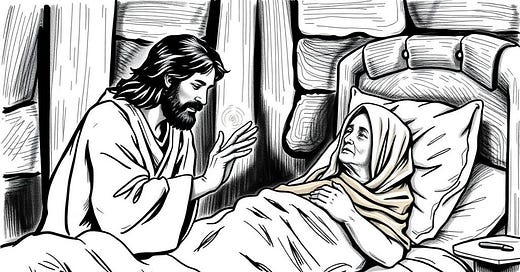Background
In Matthew 8:14-15, Jesus heals Peter’s mother-in-law of a fever. In the ancient world, fevers were often life-threatening due to limited medical knowledge. Some scholars suggest this may have been a severe infection or even malaria, which was especially deadly in the region because:
Lack of effective treatments – Ancient remedies were often powerless against parasitic diseases.
High mortality rates – Infectious diseases can quickly become fatal, particularly for the elderly or weak.
Endemic presence – The marshy areas around Galilee were breeding grounds for malaria-carrying mosquitoes.
Matthew includes this miracle to demonstrate Jesus’ absolute authority over sickness—not just as a healer, but as the Messiah fulfilling prophecy (Isaiah 53:4). It also reveals Christ’s compassion in intimate, domestic settings, not just public displays of power.
Scripture
“When Jesus came into Peter’s house, He saw Peter’s mother-in-law lying in bed with a fever. He touched her hand, and the fever left her. Then she got up and began to serve Him.” (Matthew 8:14-15, NKJV)
Reflection
This miracle reveals the profound nature of Christ’s healing power. When Jesus touched Peter’s mother-in-law, her fever vanished instantly. There was no gradual recovery and no lingering weakness. This immediate restoration demonstrates His complete authority over sickness, proving that when the Son of God acts, creation obeys. Unlike gradual recoveries (e.g., Mark 8:22-26), this healing was total and immediate with no lingering weakness. The same word is used for forgiveness of sins (e.g., Matthew 9:2), tying physical healing to spiritual restoration.
The use of aphiēmi underscores that Jesus’ healing is a liberating act of authority, not just medical recovery. It means “to let go, release, forgive, or leave.” In this context it carries the sense of “the fever left her”—implying a complete and immediate release from sickness. The word emphasizes Jesus’ sovereign power to dismiss illness with a word or touch. Just as He “releases” us from sin, He “releases” us from sickness—both by His word.
The woman’s response is equally striking. Rather than resting after her ordeal, she rose at once and began serving Jesus. Her actions model the proper response to divine healing: not passive gratitude, but active service.
This passage challenges us to consider how quickly and thoroughly we respond when Christ works in our lives. Unlike modern medicine, which often requires protracted recovery, Jesus’ healing is total and transformative. Whether He’s mending physical infirmities, emotional wounds, or spiritual brokenness, His touch brings wholeness that demands a response. The scene portrays Christ’s power, the recipient’s gratitude, and the beautiful cycle of receiving grace and extending service.
Application
This passage calls us to respond in three practical ways. First, we must bring our needs—physical, emotional, or spiritual—to Jesus with unwavering confidence in His power to heal and restore. Just as He cared for Peter’s mother-in-law in her suffering, He remains attentive to our struggles today. The miraculous accounts of missionary John G. Lake powerfully illustrate this truth: scientists documented how bacteria instantly died upon touching his skin, demonstrating Christ’s living power working through a submitted believer. Second, the healed woman’s immediate service challenges us to express gratitude through action. When God intervenes in our lives, our natural response should be to serve Him and others with the strength He provides. Finally, this miracle reminds us that Christ’s authority extends even to the most personal, seemingly mundane areas of life. No need is too trivial for His attention, and no healing is beyond His power—whether through His direct touch (as with Peter’s mother-in-law) or His manifest presence in believers (as with Lake). As we reflect on this passage, let us examine where we need His touch, how we can serve Him more faithfully, and whether we truly trust His sovereignty over every facet of our existence.
Prayer
Dear Lord Jesus,
Thank You for Your healing touch in my life. Just as You restored Peter’s mother-in-law, restore me where I am weak. You heal our disease and cause sickness to leave. Drive away sickness and infirmity in Jesus name!
Awaken in me the same readiness to serve You with my whole being. Strengthen my faith to believe that no sickness, sin, or struggle is beyond Your power to heal. May my life reflect the same immediate gratitude and service as this woman’s did. In Jesus name we pray. Amen.
Journal Prompts
Where do I need Jesus’ healing touch most urgently right now?
How has God restored me in the past, and how did I respond?
What is one practical way I can serve others this week as an act of gratitude for God’s grace and what he has already done in me?
May this passage remind you that Christ’s power is immediate, His compassion is personal, and our response must be one of radical faith and active service.






Love this !!